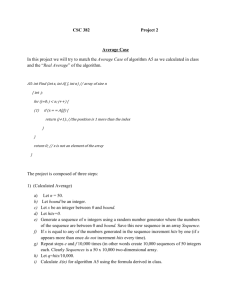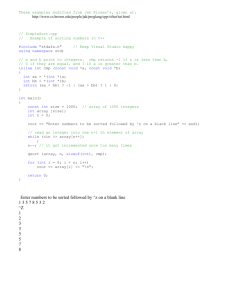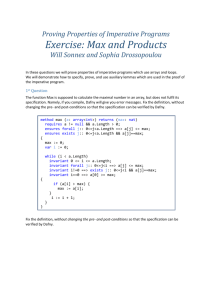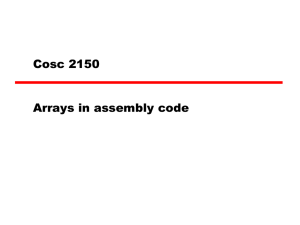Array Questions
advertisement
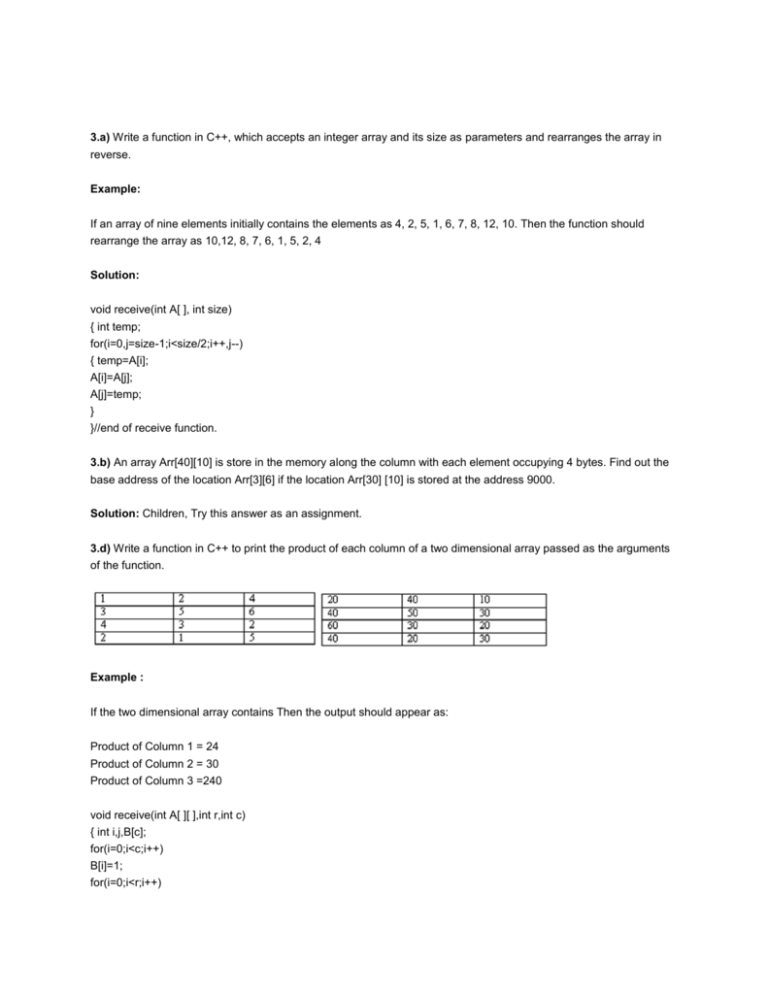
3.a) Write a function in C++, which accepts an integer array and its size as parameters and rearranges the array in
reverse.
Example:
If an array of nine elements initially contains the elements as 4, 2, 5, 1, 6, 7, 8, 12, 10. Then the function should
rearrange the array as 10,12, 8, 7, 6, 1, 5, 2, 4
Solution:
void receive(int A[ ], int size)
{ int temp;
for(i=0,j=size-1;i<size/2;i++,j--)
{ temp=A[i];
A[i]=A[j];
A[j]=temp;
}
}//end of receive function.
3.b) An array Arr[40][10] is store in the memory along the column with each element occupying 4 bytes. Find out the
base address of the location Arr[3][6] if the location Arr[30] [10] is stored at the address 9000.
Solution: Children, Try this answer as an assignment.
3.d) Write a function in C++ to print the product of each column of a two dimensional array passed as the arguments
of the function.
Example :
If the two dimensional array contains Then the output should appear as:
Product of Column 1 = 24
Product of Column 2 = 30
Product of Column 3 =240
void receive(int A[ ][ ],int r,int c)
{ int i,j,B[c];
for(i=0;i<c;i++)
B[i]=1;
for(i=0;i<r;i++)
for(j=0;j<c;j++)
B[j]=B[j]*A[i][j];
for(i=0;i<c;i++)
cout<<”\nProduct of Column “<<i+1<<” = “<<B[i];
}
3.a) Write a function in C++, which acceptsan integer array and its size as arguments and swap the elements of
every even location with its following odd location.
Example : If an array of nine elements initially contains the elements as 2,4,1,6,5,7,9,23,10 then the function should
rearrange the array as 4,2,6,1,7,5,23,9,10.
void SwapArray(int A[ ], int N)
{ int i,j,temp;
/* cout<<”\nThe elements before doing the desired alterations…”;
for(i=0;i<N;i++)
cout<<A[i]<<’\t’; */
for(i=0;i<N-1;i+=2)
{ temp=A[i];
A[i]=A[i+1];
A[i+1]=temp;
}
/* cout<<”\nThe elements after completed the desired
alterations…”;
for(i=0;i<N;i++)
cout<<A[i]<<’\t’; */
}
3.b) An array Arr[50][10] is store in the memory along the row with each element occupying 2 bytes. Find out the
Base address of the location Arr[20][50], if the location Arr[10][25] is stored at the address 10000.
Solution: Children, Try this answer as an assignment.
3.d) Write a function in C++ to print the product of each row of a two dimensional array passed as the arguments of
the function
Example: if the two imensional array contains Then the output should appear as:
Product of Row 1 = 8000
Product of Row 2 = 6000
Product of Row 3 =3600
Product of Row 4 = 2400
void receive(int A[ ][ ],int r,int c)
{ int i,j,B[r];
for(i=0;i<r;i++)
B[i]=1;
for(i=0;i<r;i++)
for(j=0;j<c;j++)
B[i]=B[i]*A[i][j];
for(i=0;i<r;i++)
cout<<”\nProduct of Row “<<i+1<<”
= “<<B[i];
}
3.a) Write function in C++ which accepts aninteger array and size as arguments and replaces elements having odd
values with thrice its value and elements having even values with twice its value. Example : if an array of five
elements initially contains elements as 3, 4, 5, 16, 9
The the function should rearrange the content of the array as 9, 8, 75, 32, 27
Solution:
void manipulate (int a[ ],int size)
{ for (i=0;i<size;i++)
{ if (a[i]%2= =1)
a[i]=a[i]*3;
else
a[i]=a[i]*2;
cout<<a[i]<<’,’;
}
}
3.b) An array Array[20][15] is stored in the memory along the column with each element occupying 8 bytes. Find out
the base address of the element Array[2][3] if the element Array[4][5] is stored at the address 1000.
Solution:
Given Data: Aray [20][15] W=8 B=?
R=20 C=15 Lr = 0 Lc = 0
Address of Array [2][3] =?Address of Array[4][5] =1000.
Address of an element (I,J) in column major =B + W ( (I-Lr) + R(J-Lc ) )
Therefore 1000=B+8*((4-0)+20(5-0))
1000=B+8*(4+20*5)
1000 =B+8*104
1000=B+832
B =1000-832
B =168
Therefore Address of Array[2][3]=168+8*((2-0)+20(3-0))
=168+8*(2+20*3)
=168+8*62
=168+496
=664
3.d) Write a function in C++ which accepts a 2D array of integers and its size as arguments and displays the
elements which lie on diagonals. [Assuming the 2D Array to be a square matrix with odd dimension i.e., 3x3, 5x5 ,7x7
etc…]
Example : if the array content is
5
4
3
6
1
7
2
8
9
Out put through the function should be :
Diagonal One : 5
Diagonal Two : 3
7
7
9
1
Solution:
void accept(int a[ ][ ],int size)
{ cout<<"Diagonal One:";
for (int i=0;i<size;i++)
for(int j=0;j<size;j++)
if (i= = j)
cout<<a[i][j]<<’\t’;
cout<<"\n Diagonal Two:";
for (i=0;i<size;i++)
for(j=0;j<size;j++)
if((i+j)= =(size-1))
cout<<a[i][j]<<’\t’;
}
3.a) Write a function in C++ which accepts an integer array and its size as arguments and replaces elements having
even values with its half and elements having odd values with twice its value .
Example : If an array of five elements initially contains the elements as 3, 4, 5, 16, 9. then the function should
rearrange content of the array as 6, 2, 10, 8, 18
Solution:
void accept(int a[ ],int size)
{ for (int i=0;i<size;i++)
{ if (a[i]%2= =0)
a[i]=a[i]/2;else
a[i]=a[i]*2;
cout<<a[i]<<’,’;
}
}
3.b) An array Arr[15][20] is stored in the memory along the row with each element occupying 4 bytes. Find out the
Base address of the location Arr[3][2], if the location Arr[5][2] is stored at the address 1500.
Solution: Given Data: Arr[15][20] W=4 B=? R=15 C=20 Lr = 0 Lc = 0 Address of Arr[3][2] = ?
Address of Arr[5][2] = 1500.
Address of an element (I,J) in row major = B+W(C(I-Lr)+(J-Lc ))
Therefore, 1500 = B+4(20(5-0)+(2- 0))
1500 = B+4(20*5+2)
1500 = B+4*102
1500 = B+408
B =1500-408
B=1092
Address of Arr[3][2] =1092+4(20*3+2)
=1092+4(62)
=1092+248
=1340.
3.d) Write a function in C++ which accepts a 2D array of integers and its size as arguments and displays the
elements of middle row and the elements of middle column. [Assuming the 2D Array to be a square matrix with odd
dimension i.e., 3x3, 5x5, 7x7 etc…]
Example : If the array content is
3
7
5
6
4
9
2
1
8
Output through the function should be :
Middle Row : 7 6 9
Middle Column : 5 6 1
Solution:
void accept(int a[ ][ ],int size)
{ cout<<"Middle Row:";
for (int i=0;i<size;i++)
for(int j=0;j<size;j++)
if (i= = size/2)
cout<<a[i][j]<<’\t’;
cout<<"\n Middle Column:";
for (i=0;i<size;i++)
for(j=0;j<size;j++)
if(j= =size/2)
cout<<a[i][j]<<’\t’;
3.a) Write function in C++ which accepts aninteger array and size as arguments andassign values into a 2D array of
integers in the following format : If the array is 1, 2, 3, 4, 5, 6 The resultant 2D array is given below
1
1
2
2
3
3
4
4
5
5
6
0
1
1
2
2
3
3
4
0
0
0
0
0
1
1
2
0
0
0
0
0
0
0
0
0
If the array is 1, 2, 3.The resultant 2D array is given :
1
1
2
2
3
0
1
0
0
Solution:
void input (int a[ ],int size)
{ int b[size] [size];
for (int i=0;i.<size;i++)
{
for (int j=0;j<size;j++)
{
if(( i+j)>=size)
b[i][j]=0;
else
b[i][j]=a[j];
cout<<b[i][j]<<’\t’;
}
cout<<endl;
}
}
3.b) An array MAT[30][10] is stored in the memory along column wise with each element occupying 8 bytes of the
memory. Find out the Base address and the address of element MAT[20][5] , if the location MAT[3][7] is stored at the
address 1000.
Solution: Children, Try this answer as an assignment.
3.a) Write function in C++ which accepts an integer array and size as arguments and assign values into a 2D array of
integers in the following format :
If the array is 1, 2, 3, 4, 5, 6
The resultant 2D array is given below :
1
1
0
2
0
0
0 0 0
0 0 0
1
1
2
2
3
3
0
4
0
0
0
0
1
1
2
2
3
3
4
4
5
5
0
6
If the array is 1, 2, 3
The resultant 2D array is given :
1
0
0
1
1
2
2
0
3
Solution:
void input (int a[ ],int size)
{ int b[size] [size];
for (int i=0;i.<size;i++)
{ for (int j=0;j<size;j++)
{ if(( i<j)
b[i][j]=0;
else
b[i][j]=a[j];
cout<<b[i][j]<<’\t’;
}
cout<<endl;
}
}
3.a) Write a function in C++ which accepts an integer array and its size as arguments and exchanges the values of
first half side elements with the second half side elements of the array.
Example :
If an array of 8 elements initial content as 2, 4, 1, 6, 7, 9, 23, 10.The function should rearrange array as 7, 9, 23, 10,
2, 4, 1, 6
Solution:
void change(int a[ ],int size)
{
int i,j,temp;
for(i=0,j=size/2;j<size;i++,j++)
{ temp=a[i];
a[i]=a[j];
a[j]=temp;
}
}
3.b) An array Arr[15][35] is stored in the memory along the row with each of its element occupying 4 bytes . Find out
the Base address and the address of element Arr[2][5] , if the location Arr[5][10] is stored at the address 4000.
Solution: Children, Try this answer as an assignment.
3.d) Write a function in C++ to print sum of all values which either are divisible by 2 or divisible by 3 present in a 2D
array passed as the argument of the function.
Solution:
void Sum(int A[ ][ ],int R,int C)
{ int i,j,S=0;
for(i=0;i<R;i++)
for(j=0;j<C;j++)
if(A[i][j]%2= = 0 ||A[i][j]%3= = 0)
S=S+A[i][j];
cout<<”\nThe Sum of all the values which are divisible by 2 or 3 in the array = “<<S;
}
3.a) Write a function in C++ which accepts an integer array and its size as arguments and exchanges the values of
first half side elements with the second half side elements of the array.
Example :
If an array of 8 elements initial content as 8, 10, 1, 3, 17, 90, 13, 60 The function should rearrange array as 17, 90,
13, 60, 8, 10, 1, 3
3.d) Write a function in C++ to print sum of all values which either are divisible by 3 or divisible by 5 present in a 2D
array passed as the argument of the function.
Ans:void Sum(int A[ ][ ],int R,int C)
{ int S=0,i,j;
for(i=0;i<R;i++)
for(j=0;j<C;j++)
if((a[i][j]%3= =0)||(a[i][j]%5= =0))
S=S+A[i][j];
cout<<" nThe Sum of all the values which
are divisible by 3 or 5 in the array = “<<S;
}
3.a) Define the function SwapArray(int[ ],int),that would expect a 1D integer array NUMBERS and its size N. the
function should rearrange the array in such a way that the values of that locations of the array are exchanged.
(Assume the size of the array to be even).
Example :
If the array initially contains {2, 5, 9, 14, 17, 8, 19, 16}. Then after rearrangement the array should contain {5, 2, 14, 9,
8, 17, 16, 19}.
Solution:
void SwapArray(int NUMBERS[ ], int N)
{ int i,j,temp;
/* cout<<”\nThe elements before
doing the desired alterations…”;
for(i=0;i<N;i++)
cout<<NUMBERS[i]<<’\t’;
*/
for(i=0;i<N-1;i+=2)
{ temp=NUMBERS[i];
NUMBERS[i]=NUMBERS[i+1];
NUMBERS[i+1]=temp;
}
/* cout<<”\nThe elements after completed the desired alterations…”;
for(i=0;i<N;i++)
cout<<NUMBERS[i]<<’\t’; */
}
3.c) Write a function in C++ to find the sum of diagonal elements from a 2D array of type float. Use the array and its
size as parameters with float as its return type.
Solution:
float diasum(float A[ ][ ],int R,int C)
{ int i,j;
float Dsum=0.0;
for(i=0;i<R;i++)
for(j=0;j<C;j++)
if((i= = j)| | (i+j)= =(size-1))
Dsum=Dsum+A[i][j];
return Dsum;
}
3.a) Assume a array E containing elements of structure Employee is required to be arranged in descending order of
Salary. Write a C++ function to arrange same with the help of bubble sort, the array and its size is required to be
passed as parameters to the function. Definition of structrure Employee is as follows:
Struct Employee
{ int Eno;
char name[25];
float Salary;
};
Solution:
void bubble(Employee E[ ],int n)
{ int i,j;
Employee Etemp;
for(i=0;i<n;++i)
for(j=0;j<(n-1)-i ;j++)
if(E[j].salary<E[j+1].salary)
{ Etemp=E[j];
E[j]=E[j+1];
E[j+1]=temp;
}
cout<<"The details of the employee in ascending order of salary ";
for(i=0;i<n;i++)
cout<<E[i].Eno<<'\t'<<E[i].name<<’\t<< E[i].Salary<<endl;
}
3.b) An array X[30][10] is stored in the memory with each element requiring 4 bytes storage. Find out the Base
address of X is 4500, find out memory locations of X[12][8] and X[2][14], if the content is stored along the row.
Solution: Children, Try this answer as an assignment.
3.c) Write a user-defined function in C++ to display those elements of 2D array T[4][4] which are divisible by 100.
Assume the content of the array is already present and the function prototype is as follows:
void showhundred( int T[4][4]);
void showhundred(int T[4][4])
{ int i,j;
cout<<”\nThe elements in the array
which are divisible by 100 …..”;
for(i=0;i<4;i++)
for(j=0;j<4;j++)
if(T[i][j]%100= =0)
cout<<T[i][j]<<’\t’;
}
3.a) Define array and pointer.
Solution: An array refer to a named list of a finite number n of similar data elements. Each of the data elements can
be referenced respectively by a set of consecutive numbers. Arrays can be one dimensional, two dimensional or multi
dimensional. An array can be declared as :
Syntax: data_type Array_name[size];
Eg: int A[10]; //Then location of the//array are A[0], A[1],…….A[9].
int B[5][4];//This array can holds 5 X 4 = 20 elements.
3.d) The array A[20][10] is stored in the memory with each element requiring one byte of storage if the base address
of a is 0, determine the location of A[10][5] when the array A is stored by column major.
Solution: Children, Try this answer as an assignment.
3.c) Considering the following key set: 42,29,74,11,65,58, use insertion sort to sort the data in ascending order and
indicate the sequences of steps required.
Solution:In this, Suppose an array A with n elements A[1],A[2],…A[N] is in memory. The insertion sort algorithm
scans A from A[1] to A[N], insertion each element A[K] into its proper position in the previously sorted subarray
A[1],A[2],…,A[K-1].
This sorting algorithm is frequently used when n is small.
The array contains 6 elements as follows:42,29,74,11,65,58
Pass A[0]
A[1
A[2] A[3] A[4] A[5] A[6]
]
K=1
-32768
42
29
74
11
65
58
K=2
-32768
42
29
74
11
65
58
K=3
-32768
29
42
74
11
65
58
K=4
-32768
29
42
74
11
65
58
K=5
-32768
11
29
42
11
65
58
K=6
-32768
11
29
42
65
74
58
Sorted
-32768
11
29
42
58
65
74
Pass
3.a) Given two arrays of integers X and Y of sizes m and n respectively. Write a function named MERGE() which will
third array named Z, such that the following sequence is followed.
(i) All odd numbers of X from left to right are copied into Z from left to right.
(ii) All even numbers of X from left to right are copied into Z from right to left.
(iii) All odd numbers of Y from left to right are copied into Z from left to right.
(iv) All even numbers of Y from left to right are copied into Z from right to left. X, Y and Z are passed as arguments to
MERGE().
Eg. X is {3, 2, 1, 7, 6, 3} and {9, 3, 5, 6, 2, 8, 10} the resultant array Z is {3, 1, 7, 3, 9, 3, 5, 10, 8, 2, 6, 6, 2}
void MERGE(int X[ ], int m,int Y[ ],int
n,int Z[ ])
{ int mn,i,,left=0,right=mn-1;
mn=m+n;
for(i=0;i<m;i++)
if (X[i]%2= = 1)
Z[left++]=X[i];//For copying odd numbers of X into Z from left to right
else
Z[right- -]=X[i];
//For copying even number of X into Z from right to left
for(i=0;i<n;i++)
if (X[i]%2= = 1)
Z[left++]=Y[i];
//For copying odd numbers of Y into Z from left to right
else
Z[right- -]=Y[i];
//For copying even number of X into Z from right to left
}
3.c) Write a user-defined function named Lower_half() which takes 2D array A, with size N rows and N columns as
argument and prints the lower half of the array.
Eg:
Input:
2
3
1
5
0
7
2
1
5
5
7
3
8
1
1
0
3
1
4
5
9
0
1
1
5
Output:
2
7
1
2
0
5
1
7
5
0
3
4
9
1
5
Solution:
void Lower_half( int A[ ][ ],int N)
{ int i,j;
for(i=0;i<N;i++)
for(j=0;j<N;j++)
{ if(i<j)
cout<<A[i][j]<<’\t’;
cout<<endl;
}
}
3.a) Suppose A, B, C are arrays of integers of size M, N and M+N respectively. The numbers in array A appear in
ascending order while numbers in array in descending order. Write user defined function in C++ to produce third
array C by merging array A by B in ascending order. Use A, B and C as arguments in the function.
void Merge(int A[ ],int M,int B[ ],int
N,int C[ ])
{ int a,b,c;
for(a=0,b=N-1,c=0;a<M&&b>=0;)
{ if(A[a]<=B[b])
C[c++]=A[a++];
else
C[c++]=B[b--];
}
if(a<M)
{ while(a<M)
C[c++]=A[a++];
}
else
{ while(b>=0)
C[c++]=B[b--];
}
}



